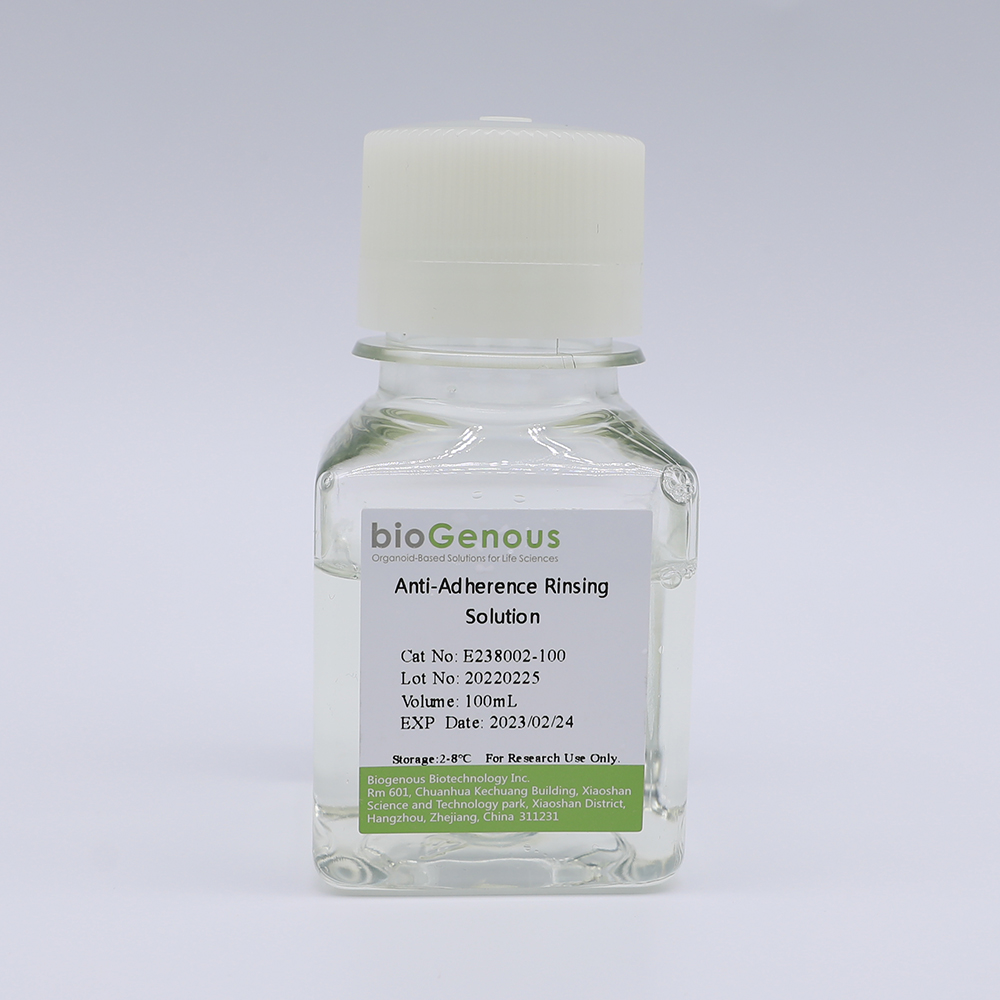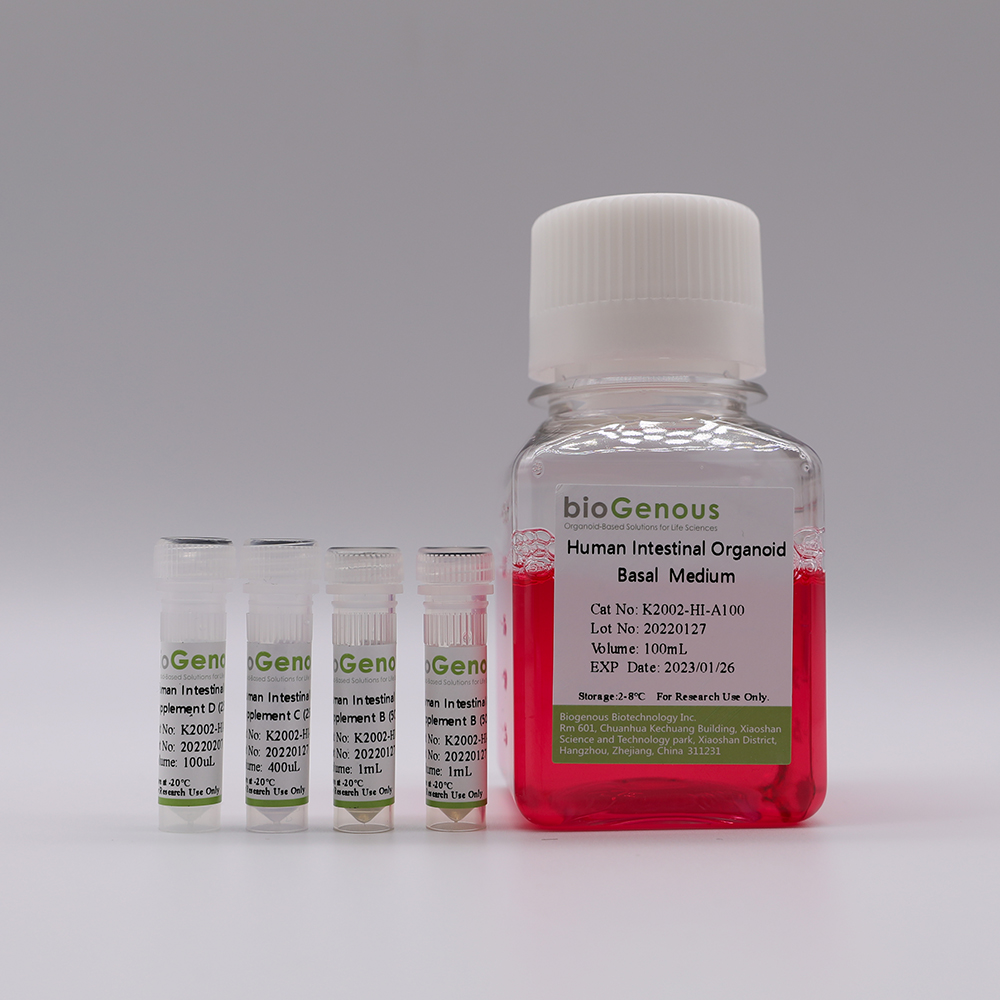bioGenous小鼠器官 Mouse Airway Organoid Kit(K2203-MA)

bioGenous小鼠器官 Mouse Airway Organoid Kit(K2203-MA)
規(guī)格:100ml
500ml
品牌:bioGenous
小鼠器官 Mouse Airway Organoid Kit
規(guī)格:100ml
500ml
品牌:bioGenous
產(chǎn)品介紹
Product Description:
bioGenousTM Mouse Airway Organoid Kit is a chemically defined cell culture medium for the establishment and maintenance of mouse airway organoids derived from mouse airway stem cells. Self-renewal of the airway epithelium is driven by the proliferation of basal stem cells. Mouse Airway organoids contain basal cells, ciliated cells, secretory cells, and a few number of neuroendocrine cells, thus the organoids display all hallmarks of the airway epithelium in terms of architecture, cell type composition and self-renewal dynamics, therefore hold great promise for the studies of airway development and disease.
技術(shù)參數(shù)
Product Information:
Component | Component Cat# | Volume | Storage & Stability |
bioGenousTM Mouse Airway Organoid Basal Medium | K2203-MA-A100/A500 | 100mL/500mL | 4℃,12 months |
2mL/10mL | -20℃,avoid repeated freeze-thaw cycles, 12 months | ||
bioGenousTM Mouse Airway Organoid Supplement C (250x) | K2203-MA-C100/C500 | 0.4mL/2mL | -20℃, avoid repeated freeze-thaw cycles, 12 months |
Preparation of Mouse Airway Organoid Complete Medium
Use a sterile technique to prepare the mouse airway organoid complete medium. The following example is for preparing 10mL complete medium. If preparing other volumes, adjust accordingly.
1. Thaw Mouse Airway Organoid Supplement B(50x) and Mouse Airway Organoid Supplement C(250x) on ice. Mix thoroughly.
NOTE: Once thawed, use immediately or aliquot and store at -20°C for not more than 10 months. After thawing the aliquots, use immediately. Do not re-freeze.
2. Add 200μL Mouse Airway Organoid Supplement B(50x) and 40μL Mouse Airway Organoid Supplement C(250x) to 9.76mL Mouse Airway Organoid Basal Medium. Mix thoroughly.
NOTE: If not used immediately, store the complete medium at 2-8°C for not more than 2 weeks. The Mouse Airway Organoid Supplement B contains fungicide and antibiotics (50x).
Protocol for Establishment of Mouse Airway Organoids
Establishment of Organoids from Primary Tissue
1. Collect primary mouse airway tissue pieces in ice-cold DPBS containing antibiotics.
2. Rinse the tissue with DPBS twice.
3. Mince the tissue into small fragments of 1-3 mm3 in a cell culture dish using surgical scissors or scalpels.
4. Digest the tissue fragments with 10mL of Tissue Digestion Solution (K601008) in a 15mL conical tube at 37°C, with variable incubation times ranging from 30 min to 1h. Carefully monitor the digestion process, mixing the content of the tube every 5-10 min by shaking vigorously or pipetting the mixture up and down. The digestion process could be finished when most of tissue fragments are able to pass through the 1mL pipette tips.
5. Add FBS to the tissue digestion mixture to a final concentration of 2%, and filter using a 100 μm cell strainer.
6. Collect and centrifuge the filtered cells at 250g for 3 min at 4 °C. In case of a visible red pellet, aspirate the supernatant, and resuspend the pellet using 2mL of Red Blood Cell Lysis Solution (E238010) to lyse the erythrocytes at room temperature for 1 min and centrifuge at 250g for 3 min at 4°C.
7. Aspirate the supernatant and resuspend the pellet in Epithelial Organoid Basal Medium (B213151), centrifuge at 250g for 3 min at 4°C, repeat this step once more time.
8. Aspirate the supernatant and resuspend the pellet in Matrigel. The Matrigel should be kept on ice to prevent it from solidifying. Perform the process as quickly as possible. The amount of Matrigel used depends on the size of the pellet. Approximately 10,000 cells should be plated in 25 μL of Matrigel.
CRITICAL: Do not dilute Matrigel too much (Matrigel should be >70% (Matrigel vol/Total vol)) to ensure formation of solid droplets.
9. Plate the Matrigel containing organoids at the bottom of 24-well cell culture plates in droplets of ~30 μL each around the center of the well..
CRITICAL:Once the organoids are resuspended in Matrigel, proceed with plating as quickly as possible, as the Matrigel may solidify in the tube or pipette tip. Do not let the Matrigel touch the wall of wells.
10. Place the culture plate into a humidified incubator at 37 °C and 5% (vol/vol) CO2 for 15-25 min to let the Matrigel solidify.
11. Prepare the required amount of mouse airway organoid complete medium.
12. Once the Matrigel droplets have solidified (15-25 min), open the plate and carefully add 500 μL of organoid complete medium to each well.
CRITICAL: Do not add the medium directly on top of the Matrigel droplets, as this might disrupt the droplets.
13. Place the culture plate in a humidified incubator at 37 °C and 5% (vol/vol) CO2.
14. Change the medium every 3-4 d by carefully aspirating the medium from the wells and replacing it with a fresh, pre-warmed organoid complete medium.
15. Closely monitor the organoid formation. Ideally, mouse airway organoids should be passaged for the first time between 7 and 10 d after the initial plating.
Splitting and Passaging of Organoids
16. Pipette up and down to disrupt the Matrigel and transfer the organoid suspension to a 1.5 mL conical tube.
17. Pipette the organoid suspension up and down to mix thoroughly by pipetting against the bottom of the tube to create pressure, which will aid the removal of Matrigel.
18. Centrifuge organoids at 250g for 3 min at room temperature.
19. Aspirate the supernatant and split organoids using either Organoid Dissociation Solution (E238001) or by mechanical disruption. For Organoid Dissociation Solution-based cell dissociation, resuspend the pellet in 0.2 mL of Organoid Dissociation Solution, pipette up and down and incubate at 37 °C until organoids fall apart. Pipette up and down with a filter tip for ≥8 times every 2 min to aid in the disruption of the organoids. Closely monitor the digestion to keep the incubation time in the Organoid Dissociation Solution to a minimum. In case of mechanical disruption, resuspend the pellet in 1.5 mL of Epithelial Organoid Basal Medium. Carefully pipette the organoid suspension up and down 30 times by pipetting against the bottom of the tube to create pressure, which will aid organoid disruption.
CRITICAL: Do not dissociate in Organoid Dissociation Solution for >6 min, as this may result in poor organoid outgrowth or even loss of the culture. As a rule of thumb, digestion is complete if a mixture of small lumps of cells (consisting of 10–50 cells) can be observed.
20. After shearing is complete, wash once by topping up with 1 mL ofEpithelial Organoid Basal Medium, and centrifuge at 250g for 3 min at room temperature.
21. Aspirate the supernatant and resuspend the organoid pellet in 70% (vol/vol) Matrigel, and plate organoids in droplets at the bottom of a culture plate as described in Steps 10. After plating is complete, transfer the plate into a humidified incubator at 37 °C and 5% (vol/vol) CO2 for 15–25 min.
22. Pre-warm mouse airway organoid complete medium at 37 °C.
23. After the Matrigel droplets have solidified (15–25 min), carefully pipette pre-warmed medium into the wells.
24. Place culture plates in a humidified incubator at 37 °C and 5% (vol/vol) CO2 until the organoids are needed for further experiments.































